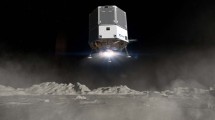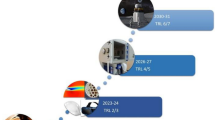Abstract
China's lunar exploration efforts have been focused on developments in space that are sustainable. To this end, the country plans to construct a manned lunar scientific research station after successfully landing on the Moon, with the aim of ensuring long-term human survival on the lunar surface and developing and utilizing lunar resources. To achieve this goal, extensive research has been conducted on the development plans and current situation of manned lunar exploration. Based on the development law of human deep-space exploration, a goal of verifying human long-term, extraterrestrial survival technology and addressing challenges, while carrying out in-depth scientific research on the Moon and exploring its resources, is proposed. After analyzing the difficulties and development trends of the station's construction, possible incremental development plans and paths for the future are discussed. Considering the four major elements of strategy, science, engineering, and economics, and focusing on the safety requirements of manned spaceflight, a preliminary idea for selecting the station location is proposed. Finally, six key technologies and challenges are analyzed with the development plan. Overall, China's commitment to lunar exploration reflects its dedication to advancing scientific knowledge and technological capabilities, while also contributing to the long-term sustainability of human presence in space.









Similar content being viewed by others
Availability of data and materials
The data used in the study are available from the corresponding author on reasonable request.
References
China Manned Space Engineering Network (2023) China's manned spaceflight project opens new chapter in space station application and development. http://www.cmse.gov.cn/xwzx/202303/t20230312_53076.html. Accessed 27 May 2023
Ge P, Zhang T, Kang X et al (2023) Progress of global deep-space exploration in 2022 and future prospects. Aerosp China 2:9–18
Peng Q, Zhang H (2023) Model-based requirements analysis method for manned space engineering. Syst Eng Electron 1–14. https://kns.cnki.net/kcms/detail/11.2422.TN.20230207.0931.001.html. Accessed 30 May 2023
Longobardo A (2021) Sample return missions: the last frontier of solar system exploration. Elsevier, Amsterdam
Dreier C (2022) An improved cost analysis of the Apollo program. Space Policy 60:101476
Chen J, Nie H, Chen C et al (2014) Design and key techniques for lunar lander system of manned lunar landing. J Astronaut 35(2):125–136
Lardier C (2018) The Soviet manned lunar program N1–L3. Acta Astronaut 142:184–192
Zhang H (2018) Trump ordered people to return to the moon. Aerosp China 1:59–61
Cahill S (2022) Returning to the moon: NASA's Artemis missions. NASA Ames Research Center, Mountain View
Wang Z (2022) Analysis of Artemis agreement in international law. Central University for Nationalities, Beijing
Liao X, Wang Y (2023) Preliminary analysis of human spaceflight development abroad in 2022. Manned Spacefl 29(1):134–142
Salotti JM (2022) Launcher size optimization for a crewed Mars mission. Acta Astronaut 191:235–244
Zhang S, Liu Y, Wang S et al (2023) Effects of lunar surface temperature and topography on outpost location selection. Chin Space Sci Technol 1–12. https://kns.cnki.net/kcms/detail/11.1859.V.20230224.0841.002.html. Accessed 30 May 2023
Wang M, Wang M, Ping J et al (2021) A review of lunar space environment study. J Deep Space Explor 8(5):486–494
Qu S, Huyan Q, Rao W et al (2021) Effects of Mars environment on landing probe mission and related design considerations. Spacecr Environ Eng 38(3):240–247
Liu X, Gao F, Deng Y et al (2022) Design and implementation of regenerative life support system in the China space station. Scientia Sinica (Technologica) 52(9):1375–1392
Guo J, Yu X, Wang P et al (2023) Lunar ultra long-distance path planning under weak global information with passability guarantee. J Astronaut 44(2):208–220
Liu J, Li X, Zhu K et al (2022) Key science and technology issues of lunar in situ resource utilization. Bull Natl Nat Sci Found China 36(6):907–918
Linli G, Ping W, Enyong Z (2013) Manned lunar base engineering. China Aerospace Press, Beijing, pp 56–80
Yu W, Li X, Wang S (2012) Effect of thermal environment on lunar exploration: a review. Adv Earth Sci 27(12):1337–1343
Wang P, Yu X, Guo J (2022) A survey of lunar wide-range exploration rover and GNC technology. J Astron 43(5):548–562
Liu Y, Zhang M, Yang Y et al (2022) Scheme design and key technology research of distributed energy system for lunar scientific research station. J Deep Space Explor 9(6):579–588
Xu Z, Yu Q, Zhang L et al (2018) Overview of 4-person, 180-day integrated experiment in controlled ecological life support system. Space Med Med Eng 31(2):264–272
Yu D, Pan B, Chao MA (2023) Research status and development prospect of planetary exploration robots. J Astron 44(4):633–643
Acknowledgement
We would highly appreciate the excellent contributions from our colleagues at China Astronauts Research and Training Center, and China Academy of Space Technology to this study.
Funding
This study was not funded by any grants.
Author information
Authors and Affiliations
Contributions
QP and PW investigated the problem, contributed the main idea, and wrote the initial draft of the paper. LX contributed to refining the ideas, reviewing and finalizing the final version.
Corresponding author
Ethics declarations
Conflict of interest
The authors have no conflicts of interest to declare that are relevant to the content of this article.
Ethical approval
This article does not contain any studies with human participants or animals performed by any of the authors.
Informed consent
For this type of study formal consent is not required.
Additional information
This is an English language translation of “Perspectives on China’s Manned Lunar Scientific Research and Test Station” originally published in Journal of Astronautics [1]. Permission was granted by all author and Journal of Astronautics.
The original online version of this article was revised: there was an error in the footnote on page 1.
Rights and permissions
Springer Nature or its licensor (e.g. a society or other partner) holds exclusive rights to this article under a publishing agreement with the author(s) or other rightsholder(s); author self-archiving of the accepted manuscript version of this article is solely governed by the terms of such publishing agreement and applicable law.
About this article
Cite this article
Peng, Q., Wang, P. & Xing, L. Perspectives on China’s Manned Lunar Scientific Research and Test Station. Adv. Astronaut. Sci. Technol. (2024). https://doi.org/10.1007/s42423-024-00155-1
Received:
Revised:
Accepted:
Published:
DOI: https://doi.org/10.1007/s42423-024-00155-1




